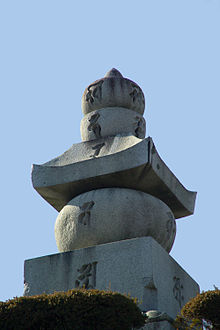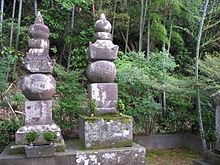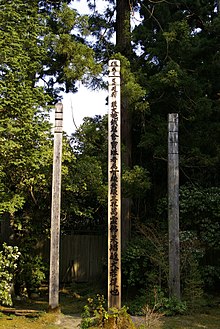Gorinto

A Gorintō ( Japanese 五 輪 塔 , dt. "5-Rings-Turm ( Tō )") is a (stone) stupa that is used in Japanese Buddhism . It was first built as a tomb or memorial stone by the Shingon and Tendai schools in the middle of the Heian period and is therefore often found on or near Buddhist cemeteries.
Other names for the Gorintō are Gorin-sotoba ( 五 輪 卒 塔 婆 ) or Gorin-gedatsu ( 五 輪 解脱 ), where sotoba is a modification of the Sanskrit word for stupa and gedatsu stands for Sanskrit Moksha 'salvation'.
The word Sotoba is the transcription of the Sanskrit word stupa , which means a sacred building in which relics of Buddha or saints are kept. The shape of the stupa has changed several times, so that its appearance varies greatly in different regions and countries.
construction
Most gorinto are made of stone, but wood, metal, and glass are possible. The Gorintō always consists of five segments, also known as rings. Each segment is assigned one of the five major elements (Sanskrit: Mahabhuta, Japanese: Godai) from Indian philosophy. Often the Sanskrit word is in Siddham script for the element in question. A geometric shape is also assigned to each element. From top to bottom these are:
| Sanskrit | character | Yep | shape | element |
|---|---|---|---|---|
| kha | 空 | kū | (Lotus flower) | Ether, energy, nothing |
| Ha | 風 | fū | Crescent moon | air |
| ra | 火 | ka | Pyramid, triangle | Fire |
| va | 水 | sui | Sphere, circle | water |
| a | 地 | chi | Cube, square | earth |
The shape for the top element differs regionally. In Japan the shape is mostly reminiscent of a lotus blossom. The top two rings (air and energy) are often combined to form a single unit. Ornaments often make it difficult to tell the individual rings apart.
In temples of the Nichiren and Tendai schools, the Gorinto often wear the Lotus Sutra .
meaning
There are different meanings, both for the Gorintō as a whole and for the individual rings. The literature then speaks of several levels of symbolism. When used as tombstones, the rings express the idea that the body passes into the five elements after death.
The Gorintō as a symbol belongs to the Mikkyō ( 密 教 ), the "secret teaching" (the translation of the word) of Buddhism, ie esoteric Buddhism . In Japanese Buddhism , the schools Shingon and Tendai are grouped together. In these schools the lower two shapes (square and circle) represent perfection, as these two shapes contain the other.
- Square and circle: They represent the Jutsuzaikai ( 実 在 界 'real world' ), the realm of perfect understanding.
- Triangle, crescent and the topmost element: They represent the henkai ( 変 界 'world of change' ), the realm of impermanence. This also includes the Genshōkai ( 現象 界 ), the world in which we live.
On a second level of symbolism, each element of the Gorintō is an element of change, both in Jutsuzaikai and Henkai:
- The top element combines the shape of the crescent moon and a triangle. The combination of these two qualities stands for perfection, the attainment of Buddhist enlightenment.
- The crescent stands for receptivity. It is an empty cup ready to receive the gifts of heaven.
- The triangle is the transition between two worlds. It symbolizes union and movement, the two things that are necessary to attain enlightenment.
- The circle represents completeness or the attainment of wisdom.
- The square is a symbol for the 4 elements fire, water, air and earth.
In a further level of symbolism, the shapes indicate the stages in which a student progresses in his spiritual studies. The stages are run through from bottom to top:
- The square is the base; the will to achieve perfection.
- The circle is the achievement of serenity.
- The triangle is the energy that arises in search of the truth.
- The crescent is the development of insight and knowledge.
- The top form is perfection itself.
History of the Gorintō in Japan
The development of the Gorintō in Japan shows a great influence of the Mikkyō teachings of the monks Kūkai and Kakuban . Their creation began in the second half of the Heian period . The oldest known Gorintō dates back to 1169 and is in Chūson-ji in Hiraizumi , Iwate Prefecture . It's a mix of Gorintō and Hōtō (a two-story Buddhist pagoda). During the Kamakura period , the Gorintō established itself as memorial and gravestones and was not only found in Buddhist temples.
In Japanese cemeteries today you can often find wooden sacrificial sticks (see photo). There are notches on the offering box that divide it into five sections. The inscription consists of the sutra and the posthumous name of the deceased. These wooden panels are basically a variant of the stupa.
credentials
- ↑ JAANUS: Tou . Retrieved July 3, 2010.
- ↑ a b Kōjien Japanese Dictionary
- ↑ a b c d e f g h Home Study Course on Basic Buddhism
- ↑ a b c Article "Gorintō", Japanese Wikipedia, accessed on April 10, 2008
- ↑ Article en: Godai , accessed on April 10, 2008
- ↑ Article Mikkyo , accessed on April 10, 2008
Other sources are:
- The Sotoba (Gorintō, Stupa) Explained , Home Study Course on Basic Buddhism accessed on April 6, 2008
- Iwanami Kōjien Japanese dictionary, 6th Edition (2008), DVD version






